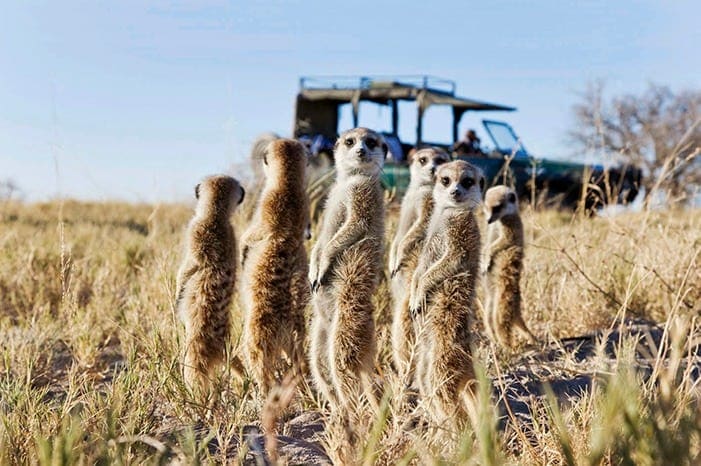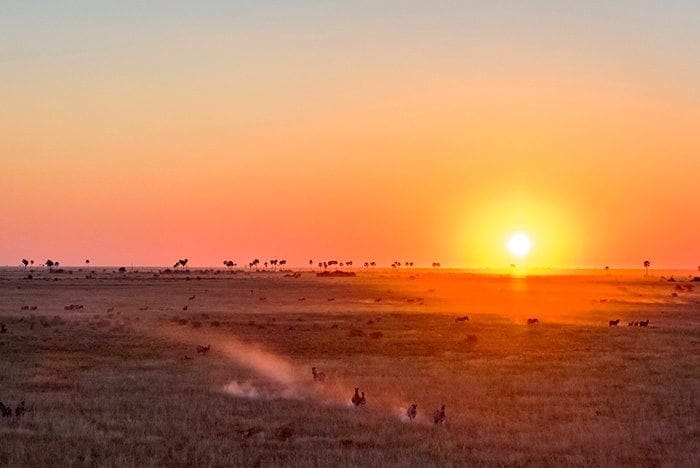Makgadikgadi
An Untold Vastness
The great Makgadikgadi Pans, covering approximately 10000 km² of the Kalahari, are nothing but salt. While some of the pans are enormous, others are the size of a small pond and surrounding them are rolling grasslands and the occasional picturesque palm-tree island. The main objective of visiting the Makgadikgadi National Park is to experience true remoteness and absolute isolation. It is vast, wild and beautiful. The subtle hues at sunset transform Makgadikgadi into a surreal wonderland unlike anywhere else. During the day, the dusty pans, with whirlwinds skirting across a seemingly endless desert, offer the best way to come face to face with true isolation.
The variety of birdlife in the Makgadikgadi area is outstanding, with white-backed and lappet-faced vultures, bateleurs, tawny and martial eagles, black-breasted snake eagles, lanner and red-footed falcons, gabar and pale chanting goshawks. Also seen are red-billed and orange river francolin, ostrich, secretary bird, guineafowl, black and red-crested korhaan, kori bustard, crowned plover, double-banded courser, spotted dikkop, all species of sandgrouse, giant eagle and pearl-spotted owls, lilac-breasted and purple rollers and large numbers of the hornbill species.
The Makgadikgadi region is home to large numbers of animals, especially zebra and wildebeest, who migrate to grasslands in the west of the park after the rains when it is possible to see these animals in their thousands. During the dry winter months, the migration moves westwards to the water available in the Boteti River. Still, many desert-adapted creatures, including meerkats, yellow mongoose, ground squirrel, aardwolf, African wildcat, caracal, spring hare, porcupine, steenbok, kudu, jackal, honey badger, genet and the occasional lion, remain resident. This is also the domain of the brown hyena, a shy and elusive creature, as well as suricates, aardvarks and small bustard species. The Boteti River is a seasonal river that relies solely on Angola's flood waters. Some years, the flood exhausts itself before reaching the river leaving it dry; other years see a transformation as the river begins to flow. The heavily wooded areas beside the Boteti River contain shy antelopes like duiker and bushbuck.

Leroo La Tau
Leroo La Tau is built on 15m high cliffs above the Boteti River, which gives guests opportunities for spectacular views and wildlife sightings from this raised vantage point. During the dry season, the Boteti area is populated by up to 30000 wildebeest and zebra, which have migrated south to the Makgadikgadi in search of grazing and, in turn, bring predator activity. However, Leroo La Tau is not only about lion, zebra and wildebeest – other species found around the lodge are leopard, brown and spotted hyena, impala, kudu, jackal, porcupines, genets and caracal, to name a few.

San Camp
San Camp overlooks the endless white salt of the extinct Makgadikgadi sea and offers a unique chance to explore the Kalahari A stay at San Camp is a true desert experience focusing on the area's geology, archaeology and anthropology as well as species unique to the area such as aardvark, gemsbok and springbok. San Camp is the only place where guests are virtually guaranteed to see the shy brown hyena rarely seen elsewhere and explore the Kalahari on walks with a gang of habituated but wild meerkats.

Jack's Camp
Jack's Camp is pitched on a low grassland knoll amongst an oasis of desert palms and Kalahari acacia alongside the awe-inspiring Ntwetwe Pan. It offers great game viewing alongside the pan, which is a haven of birdlife in the wet months and attracts bigger game during the dry months. Jack's Camp is an iconic and incredibly unique luxury camp offering an experience not found anywhere else in Botswana.

Nxai Pan
Nxai Pan is a uniquely styled camp overlooking a waterhole on the western edge of a fossil pan from which the camp takes its name. Nxai Pan is a fossil lake-bed where the landscape is largely covered by grassland, dotted with clusters of acacia trees, with some mopane woodland in the north; however, during the rains, the pans become covered in grass and attract huge herds of antelope and predators. The camp is perfectly placed for guests wanting to visit this unique and beautiful area.

